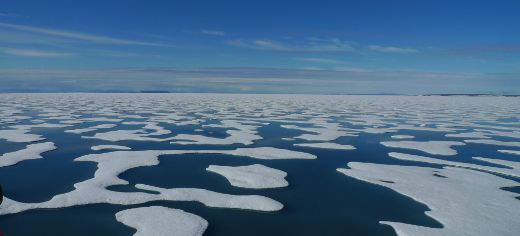
Researchers have shown for the first time that phytoplankton (plant life) in remote ocean regions can contribute to rare airborne particles that trigger ice formation in clouds.
A study published online today in the journal Nature shows that the organic waste from life in the oceans, which is ejected into the atmosphere along with sea spray from breaking waves, stimulates cloud droplets to freeze into ice particles. This affects how clouds behave and influence global climate, which is important for improved projections of future climate change.
Lead author Dr Theo Wilson, from the School of Earth and Environment at the University of Leeds, said: “Breaking waves in the ocean generate large quantities of airborne sea spray. Some sea spray particles contain biological material linked to the ocean’s ecosystem. It has been speculated in the past that some of this biological material may trigger the formation of ice in clouds – making them ‘ice nucleating particles’ (INPs) in the atmosphere.
“Now we have clear evidence that marine biological material, such as matter exuded from phytoplankton, is able to nucleate ice and could do so in the atmosphere. This could be particularly important in the polar regions.”
Clouds in the Earth’s atmosphere are made of liquid water droplets, ice particles or a mixture of both. Ice particles affect how long a cloud exists and how much rain, hail or snow it produces. They also help control temperature of the climate by reflecting sunlight or trapping heat close to the Earth’s surface.
Climate in the polar regions is changing more rapidly than any other part of the planet, yet predictions for how it will change in future remain uncertain. This improved understanding of cloud formation is a step closer to helping reduce uncertainties in global climate modelling.
In the study, an international team of researchers investigated marine life from the biological ecosystem in the Arctic Ocean, Western Atlantic and North Pacific by collecting biological matter using a remote-controlled boat launched from research ships, along with handheld sampling equipment. By combining these direct measurements with global computer modelling scenarios of the atmosphere, the team found that airborne particles from sea spray were most influential on cloud formation in polar and other remote ocean regions.
Co-lead author Dr Luis Ladino, from the University of Toronto, said: “The team also investigated specific marine life forms in the laboratory to learn more about the material we sampled. We found that a certain species of algae (Thalassiosira psuedonana, a common type of phytoplankton) release organic material that is able to nucleate ice like the INPs we found in the sea.”
Co-author and Principal Investigator of the research project behind the study, Dr Benjamin Murray, who is also from the School of Earth and Environment at the University of Leeds, said: “Understanding where ice nucleating particles come from is critical for predicting future climate. For example, as the polar ice caps shrink – we are heading for another record Arctic minimum later this month – there will be more ocean from which these particles can be emitted, and this marine source of ice nucleating particles might become more important.”
Further information
The research paper ‘A marine biogenic source of atmospheric ice
nucleating particles’ is published in the journal
Nature on 10 September.
The Arctic Research Programme (ARP), which was launched in 2010, was
funded by the Natural Environment Research Council (NERC) to address specific topics of scientific uncertainty
in the Arctic region and is coordinated and managed by a team at British
Antarctic Survey.
The NERC-funded project, ‘ICE-ACCACIA’ was led by Dr Benjamin Murray at the University of Leeds and focused on the sources of ice nucleating particles in the Arctic. This project complemented ‘ACCACIA’ which was a major consortium funded by the ARP.
The European Research Council part supported this work through ‘ICE’, a Fellowship grant awarded to Dr Benjamin Murray. This was a five year grant worth 1.7 million Euros focused on understanding ice nucleation in the Earth’s atmosphere.
Funding was also provided for Dr Theo Wilson by The Aerosol Society, which supports UK aerosol science.
Dr Theo Wilson and Dr Benjamin Murray are available for interview. Please contact Sarah Reed, Press Officer at the University of Leeds, on 0113 34 34196 or email s.j.reed@leeds.ac.uk.
Image credit: Dr Theodore W. Wilson